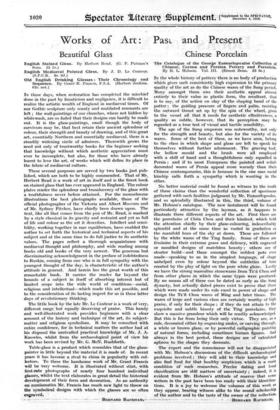Chinese Porcelain
The Catalogue of the George Eumorfopoulos Collection of ' Chinese, Corean and Persian Pottery and Porcelain. By R. L. Hobson. Vol. III. (Ernest Bonn. £6 6e.)
IN the whole history of pottery there is no body of production Which gives such consistently high expression to the primary quality of the art as do the Chinese wares of the Sung period. Many amongst them owe their aesthetic appeal almost entirely to their value as plastic form, the resultant, that is to say, of the action on clay of the shaping hand of the potter ; the guiding pressure of fingers and palm, resisting the outward thrust set up by the spin of the wheel, gives to the vessel all that it needs for aesthetic effectiveness, a quality so subtle, however, that its perception may be regarded as a true test of visual and tactile sensibility.
The age of the Sung emperors was noteworthy, not only for the strength and beauty, but also for the variety of its wares. Some of the best of these, as we 'have seen, belong to the class in which shape and glaze are left to speak for themselves without further adornment. The graving tool, the hollow mould and the brush were all employed with a skill of hand and a thoughtfulness only equalled in Persia ; and if to most Europeans the painted and relief- decorated wares of Persia appeal more warmly than their Chinese contemporaries, this is because in the one ease racial kinship calls forth a sympathy which is wanting in the other.
No better material could be found as witness to the truth of these claims than the wonderful collection of specimens gathered with such faultless judgment by Mr. Eumorfopoulos, and so splendidly illustrated in this, the third, volume of Mr. Hobson's catalogue. The new instalment will be found particularly attractive by the layman, as it happens to illustrate three different aspects of the art. First there are the porcelains of Chiin Chou and their kindred, which hold the attention chiefly by their glaze-colouring, indescribably splendid and at the same time as Varied in gradation as the manifold hues of the sky at dawn. These are followed by the white wares of the Ting family. Some of these are feminine in their extreme grace and delicacy, with engraved or moulded designs of matchless beauty ; others are of stouter build—and these amongst the noblest pots ever made—speaking to us in the simplest language, of shape unhelped even by colour beyond the subtleties of tone created by the play of light on the pure white glaze. Lastly we have the strong masculine stonewares from Tz'd Chou and from other places in which the same types were produced. By no means all of these can be dated as early as the Sung dynasty, but actually dated pieces exist to prove that those which were made under its rule excel in power of shape and design the Tz'ft Chou wares of Ming and later times. The wares of large and various class are certainly worthy of high praise, if only for their shape ; -if they do not attain to the exquisite and subtle biouty of the Ting porcelains, they show a massive grandeur which will be readily acknowledged. But this is far from being their only virtue. They are, as a rule, decorated either by engraving under, or carving through, a white or brown glaze, or by powerful calligraphic painting of natural forms, including sometimes human figures. And always in the best period, these designs are of calculated aptness to the shapes they decorate.
The expert and the connoisseur will not be disappointed with Mr. Hobson's discussions of the difficult archaeological problems involved ; they will add to their knowledge and aLso find food for that healthy scepticism which is a main condition of such researches. Precise dating and local classification are still matters of uncertainty ; indeed, it is evident from Mr. Hobson's attitude of reserve that some writers in the past have been too ready with their identifica- tions. It is a joy to welcome the volumes of this work as they appear, bearing witness alike to the sound scholarship of the author and to the taste of the owner of the collection.
- • • =BERNARD RACRIIAN•






























































 Previous page
Previous page